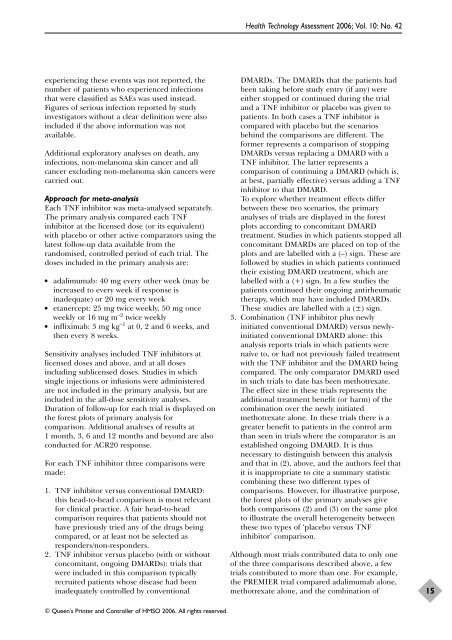A systematic review of the effectiveness of adalimumab
A systematic review of the effectiveness of adalimumab
A systematic review of the effectiveness of adalimumab
You also want an ePaper? Increase the reach of your titles
YUMPU automatically turns print PDFs into web optimized ePapers that Google loves.
experiencing <strong>the</strong>se events was not reported, <strong>the</strong><br />
number <strong>of</strong> patients who experienced infections<br />
that were classified as SAEs was used instead.<br />
Figures <strong>of</strong> serious infection reported by study<br />
investigators without a clear definition were also<br />
included if <strong>the</strong> above information was not<br />
available.<br />
Additional exploratory analyses on death, any<br />
infections, non-melanoma skin cancer and all<br />
cancer excluding non-melanoma skin cancers were<br />
carried out.<br />
Approach for meta-analysis<br />
Each TNF inhibitor was meta-analysed separately.<br />
The primary analysis compared each TNF<br />
inhibitor at <strong>the</strong> licensed dose (or its equivalent)<br />
with placebo or o<strong>the</strong>r active comparators using <strong>the</strong><br />
latest follow-up data available from <strong>the</strong><br />
randomised, controlled period <strong>of</strong> each trial. The<br />
doses included in <strong>the</strong> primary analysis are:<br />
● <strong>adalimumab</strong>: 40 mg every o<strong>the</strong>r week (may be<br />
increased to every week if response is<br />
inadequate) or 20 mg every week<br />
● etanercept: 25 mg twice weekly, 50 mg once<br />
weekly or 16 mg m –2 twice weekly<br />
● infliximab: 3 mg kg –1 at 0, 2 and 6 weeks, and<br />
<strong>the</strong>n every 8 weeks.<br />
Sensitivity analyses included TNF inhibitors at<br />
licensed doses and above, and at all doses<br />
including sublicensed doses. Studies in which<br />
single injections or infusions were administered<br />
are not included in <strong>the</strong> primary analysis, but are<br />
included in <strong>the</strong> all-dose sensitivity analyses.<br />
Duration <strong>of</strong> follow-up for each trial is displayed on<br />
<strong>the</strong> forest plots <strong>of</strong> primary analysis for<br />
comparison. Additional analyses <strong>of</strong> results at<br />
1 month, 3, 6 and 12 months and beyond are also<br />
conducted for ACR20 response.<br />
For each TNF inhibitor three comparisons were<br />
made:<br />
1. TNF inhibitor versus conventional DMARD:<br />
this head-to-head comparison is most relevant<br />
for clinical practice. A fair head-to-head<br />
comparison requires that patients should not<br />
have previously tried any <strong>of</strong> <strong>the</strong> drugs being<br />
compared, or at least not be selected as<br />
responders/non-responders.<br />
2. TNF inhibitor versus placebo (with or without<br />
concomitant, ongoing DMARDs): trials that<br />
were included in this comparison typically<br />
recruited patients whose disease had been<br />
inadequately controlled by conventional<br />
© Queen’s Printer and Controller <strong>of</strong> HMSO 2006. All rights reserved.<br />
Health Technology Assessment 2006; Vol. 10: No. 42<br />
DMARDs. The DMARDs that <strong>the</strong> patients had<br />
been taking before study entry (if any) were<br />
ei<strong>the</strong>r stopped or continued during <strong>the</strong> trial<br />
and a TNF inhibitor or placebo was given to<br />
patients. In both cases a TNF inhibitor is<br />
compared with placebo but <strong>the</strong> scenarios<br />
behind <strong>the</strong> comparisons are different. The<br />
former represents a comparison <strong>of</strong> stopping<br />
DMARDs versus replacing a DMARD with a<br />
TNF inhibitor. The latter represents a<br />
comparison <strong>of</strong> continuing a DMARD (which is,<br />
at best, partially effective) versus adding a TNF<br />
inhibitor to that DMARD.<br />
To explore whe<strong>the</strong>r treatment effects differ<br />
between <strong>the</strong>se two scenarios, <strong>the</strong> primary<br />
analyses <strong>of</strong> trials are displayed in <strong>the</strong> forest<br />
plots according to concomitant DMARD<br />
treatment. Studies in which patients stopped all<br />
concomitant DMARDs are placed on top <strong>of</strong> <strong>the</strong><br />
plots and are labelled with a (–) sign. These are<br />
followed by studies in which patients continued<br />
<strong>the</strong>ir existing DMARD treatment, which are<br />
labelled with a (+) sign. In a few studies <strong>the</strong><br />
patients continued <strong>the</strong>ir ongoing antirheumatic<br />
<strong>the</strong>rapy, which may have included DMARDs.<br />
These studies are labelled with a (±) sign.<br />
3. Combination (TNF inhibitor plus newly<br />
initiated conventional DMARD) versus newlyinitiated<br />
conventional DMARD alone: this<br />
analysis reports trials in which patients were<br />
naïve to, or had not previously failed treatment<br />
with <strong>the</strong> TNF inhibitor and <strong>the</strong> DMARD being<br />
compared. The only comparator DMARD used<br />
in such trials to date has been methotrexate.<br />
The effect size in <strong>the</strong>se trials represents <strong>the</strong><br />
additional treatment benefit (or harm) <strong>of</strong> <strong>the</strong><br />
combination over <strong>the</strong> newly initiated<br />
methotrexate alone. In <strong>the</strong>se trials <strong>the</strong>re is a<br />
greater benefit to patients in <strong>the</strong> control arm<br />
than seen in trials where <strong>the</strong> comparator is an<br />
established ongoing DMARD. It is thus<br />
necessary to distinguish between this analysis<br />
and that in (2), above, and <strong>the</strong> authors feel that<br />
it is inappropriate to cite a summary statistic<br />
combining <strong>the</strong>se two different types <strong>of</strong><br />
comparisons. However, for illustrative purpose,<br />
<strong>the</strong> forest plots <strong>of</strong> <strong>the</strong> primary analyses give<br />
both comparisons (2) and (3) on <strong>the</strong> same plot<br />
to illustrate <strong>the</strong> overall heterogeneity between<br />
<strong>the</strong>se two types <strong>of</strong> ‘placebo versus TNF<br />
inhibitor’ comparison.<br />
Although most trials contributed data to only one<br />
<strong>of</strong> <strong>the</strong> three comparisons described above, a few<br />
trials contributed to more than one. For example,<br />
<strong>the</strong> PREMIER trial compared <strong>adalimumab</strong> alone,<br />
methotrexate alone, and <strong>the</strong> combination <strong>of</strong><br />
15
















